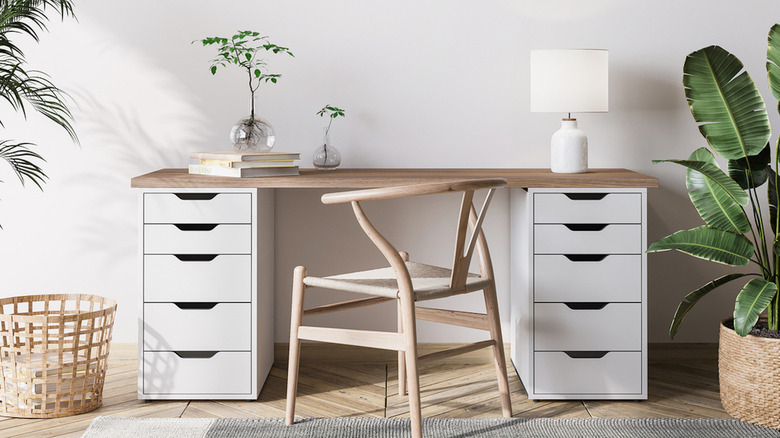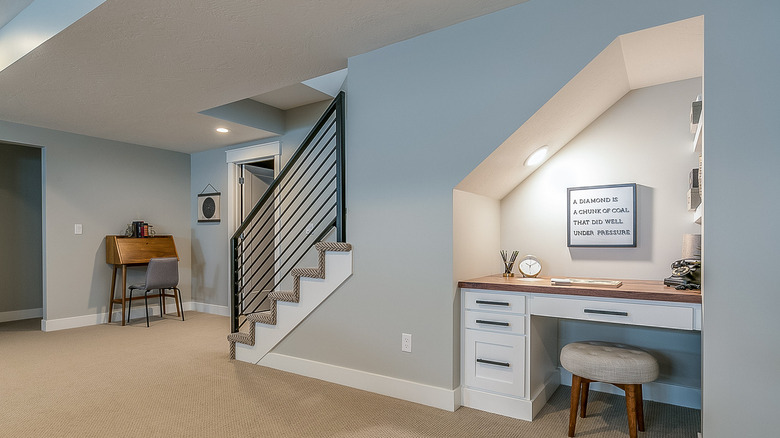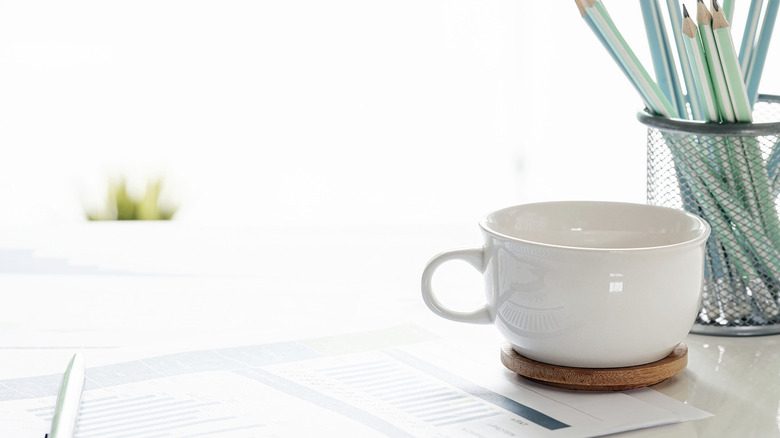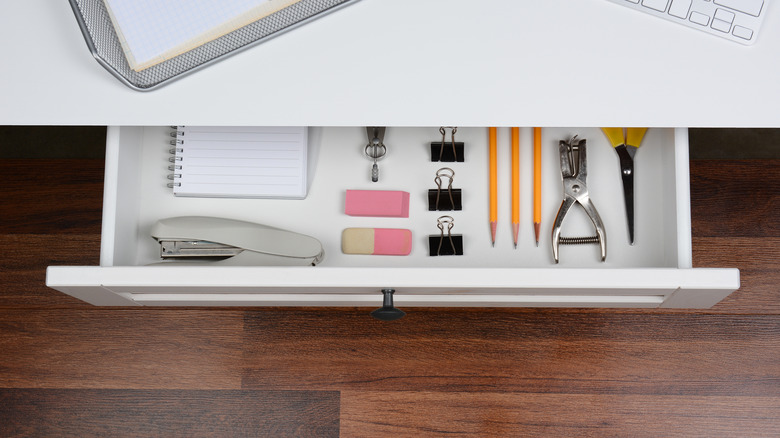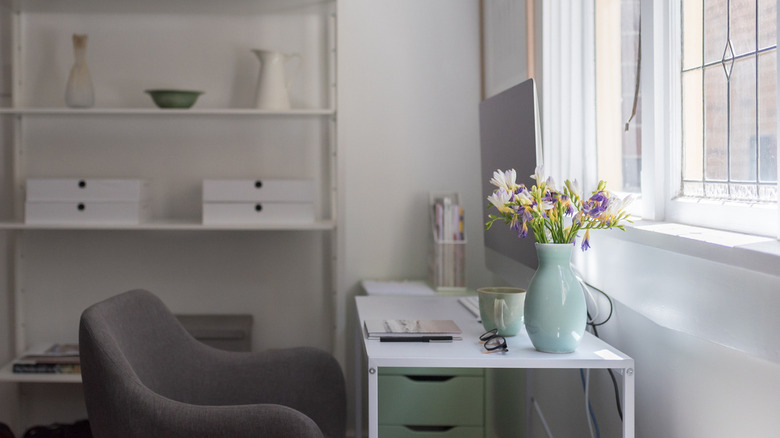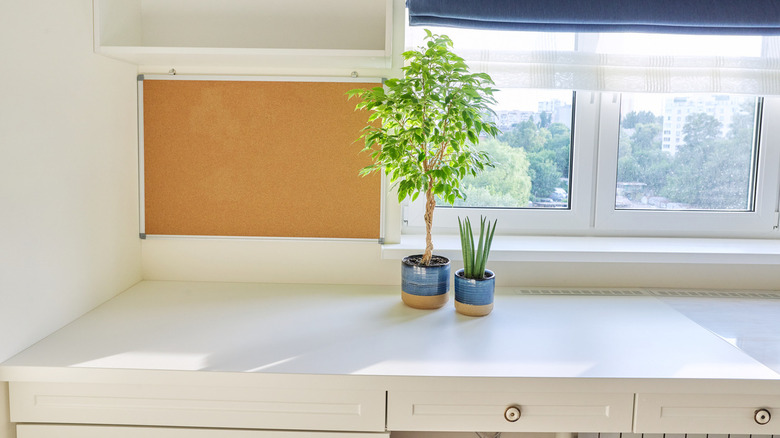5 Things Every Organized Home Office Needs
Gone are the days when the notion that working from home is somehow a novelty or luxury. Or, perhaps, simply a short-term solution to help ward off a global pandemic. Like many corporate employees, full-time or hybrid remote work may be your new normal for the foreseeable future. According to research by Ladders, 25% of all North American personnel will be telecommuting by the end of 2022, with the job search site forecasting that figure to increase again next year.
If you find yourself in this population, having a functional home office is more important than ever. While kids, partners, pets, contractors, and delivery drivers all serve as added distractions throughout the day that are (usually) out of your control, on the flip side, having an organized workspace is something you do have the ability to manage. If you tend to err on the side of disorganization, it would greatly benefit you to tackle your desk and surrounding area.
That's because having an organized workstation saves precious minutes in your day since you know where everything is located and you're less likely to be distracted by clutter. While every option looks different, with some being their own room and others existing in a corner of the kitchen, there are some basic guidelines to follow if you'd like to have your space streamlined.
Read on to find out the five things every organized home office needs to function properly.
A dedicated spot
The very first step in achieving an organized workspace is to decide where it should be located. If you're fortunate enough to dedicate a separate room for your office, this decision becomes a bit easier. However, it's possible to create one virtually anywhere in your home.
Consider using a corner of your living room, family room, dining room, bedroom (yours or one reserved for guests), sunroom, kitchen, or basement to set up shop. You can also get creative and use a nook under the stairs, carve out a "cloffice," or even use the garage if it's climate-controlled.
If you're really tight on space, The Home Edit suggests picking a spot where there's a blank wall and making the most of the verticality. Additionally, installing systems like floating shelves and pegboards allows you to store office necessities. Simply place a small desk or table and chair below the shelves and board for a compact home office.
Professional organizer Jane Stoller shared with Forbes the suggestion of using a partition, if necessary. Just like visual clutter on top of or around your desk can be a distraction (more on that in a moment), catching your child's toys out of the corner of your eye while on an important call can throw off your focus. As such, giving yourself an actual barrier can also help keep stray items out of your office, allowing this area to stay neater in the long run.
A desktop organizer
Once you have a designated spot for your home office, it's important to keep it as clutter-free as possible. Why? According to Becoming Minimalist, some of the benefits include improved focus, the ability to tackle any project at any moment, and walking into a fresh space each day. Essentially, a well-organized desk allows you to work freely without obstacles, whether they be mental or physical.
The easiest way to achieve this, as Becoming Minimalist suggests, is to maximize your surroundings. Having less stuff is ultimately easier than organizing more of it. However, there will always be something work-related that you need to do your job efficiently — and that's where a good desktop organizer comes in handy.
Determining what those things are is the first step before choosing an organizer. Per Erin Condren, we often leave supplies on our desks that we don't use on a regular basis because we're in the habit of them laying there. From pens to sticky notes, decide what actually belongs, and then find a desktop organizer to keep them in place. It can be as simple as an old coffee mug that serves as a pencil and scissor holder or something more elaborate, such as a computer riser with compartments to store binder clips and notebooks.
Whatever you decide on, be sure it's proportional to your desk and easy to use.
A place for overstock office supplies
For the supplies that you'd like to keep but don't use every day, it's a good idea to give them a home elsewhere. Ideally, this spot should be in or near your office. But if space is lacking, these items can live anywhere in your home — as long as you know where they're located when you need something.
Say you don't have an excess amount of supplies and your desk contains a drawer or two. Then, the easiest solution is to make this the overstock spot. In need of inspiration? The Container Store suggests using organizers, whether opting for a tray with compartments or individual inserts that you can customize to your liking to keep the drawers in order.
Now, if you're again running short on desktop real estate, consider a nearby or less-often-used closet to create an overstock office supply center. Use clear, stackable bins with labels to sort extra Sharpies and staples. This way, when you need to replace the dried-out marker in your pencil cup or if your stapler is empty, you'll know exactly where to find what you need without crowding your workspace.
Other storage options include a standing unit that includes a combination of shallow and deeper drawers for a variety of office supplies. Or, as Life With Less Mess suggests, a three-tier rolling cart that not only holds a good quantity of things, but is also portable.
A small filing system
These days, you more than likely perform your job duties digitally. However, you may also use your home office to store personal and household documents as well. If this is the case, perhaps a small filing system is all you need.
A wall-mounted organizer, cardboard file box, or bench with storage (which can be a great way to disguise paperwork while maintaining your home's aesthetic) can all be used to keep folders neat and within reach. Label each category and create subfolders if necessary. You may even find that a dual "in" and "out" system is all you actually need.
If you do have a lot of paperwork, The Container Store recommends using a filing cabinet. Stick to a two-drawer style to avoid your home feeling like a corporate office. Plus, going through and shredding or discarding papers on a regular basis helps to minimize any stockpiles. For important paperwork that you must keep long term, such as records that your role requires you to hold onto, The Container Store also advises using a bin with a latching lid and storing that out of the way, such as in the basement or attic.
Want to aim to be completely paperless? Try going digital with your system, which, as Abby Organizes explains, has helped to eliminate the need for a filing cabinet altogether and, therefore, physical paper clutter.
A wall calendar or memo board
Again, you're more than likely working from the comfort of home. But if you're the visual type who benefits from creating to-do lists or marking down important dates, then a wall calendar and/or memo board is something your home office needs. Not only will you see some benefits when it comes to your work by using one, but it also helps to eliminate clutter on and around your desk.
An acrylic or chalkboard monthly calendar allows you to see the big picture and make your own notes about deadlines and reminders, without your boss or colleagues seeing it on a shared scheduler. Plus, according to The Street, it helps with productivity and motivation. Consistently seeing a due date in front of you will help stave off procrastination, and you can even customize it with photos and inspirational quotes to keep you on track.
Additionally, consider using a memo board (or a combination memo and calendar if you'd prefer). It can be cork or, as Clean Mama explains, an inexpensive dry-erase board to use as a means to lay out your goals and keep track of them.
Whichever style you choose, be sure to utilize it on a daily or at least weekly basis in order to use it to your advantage. Similarly to going through paperwork regularly, update and adjust your wall calendar and memo board as often as possible.
